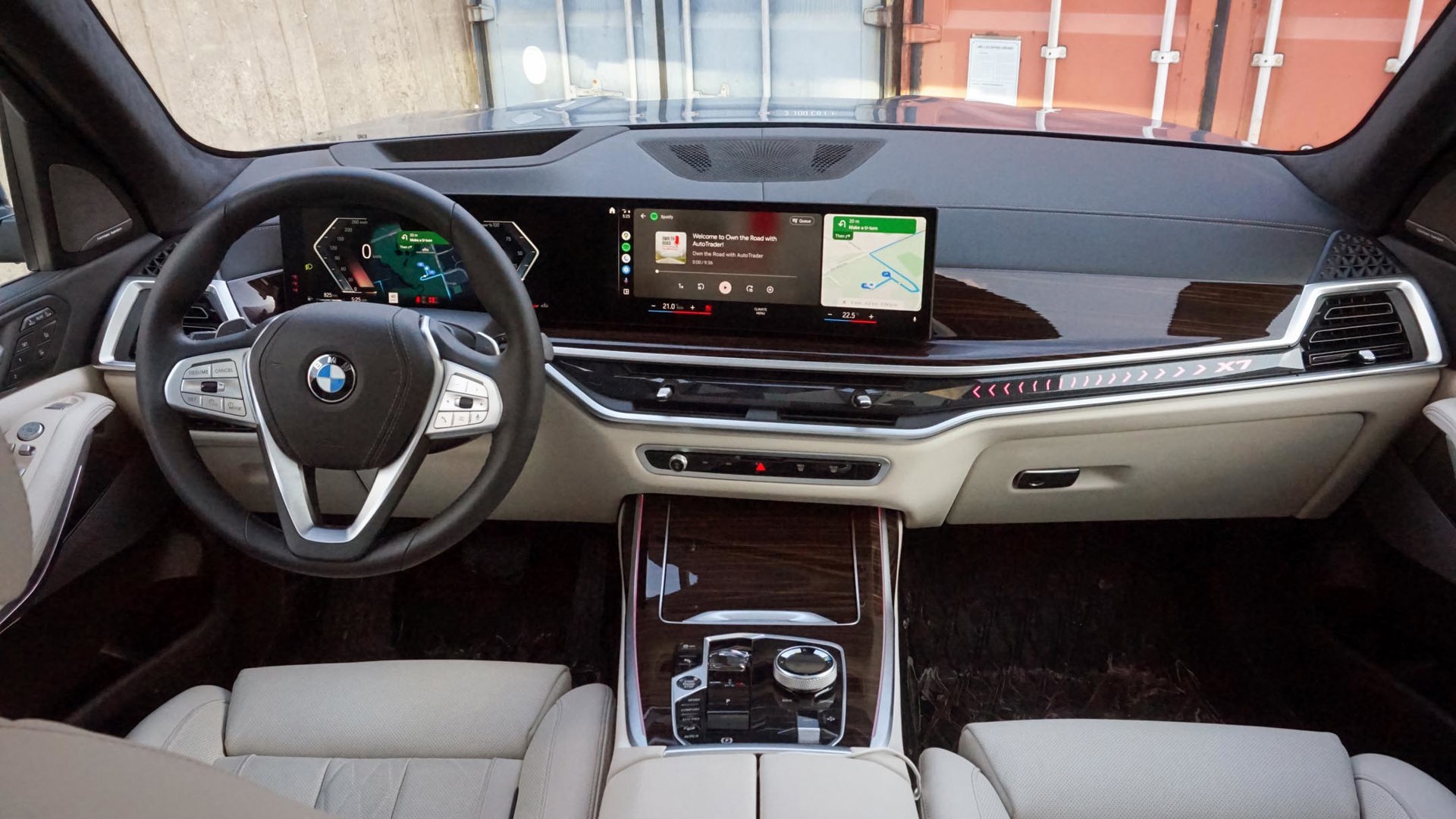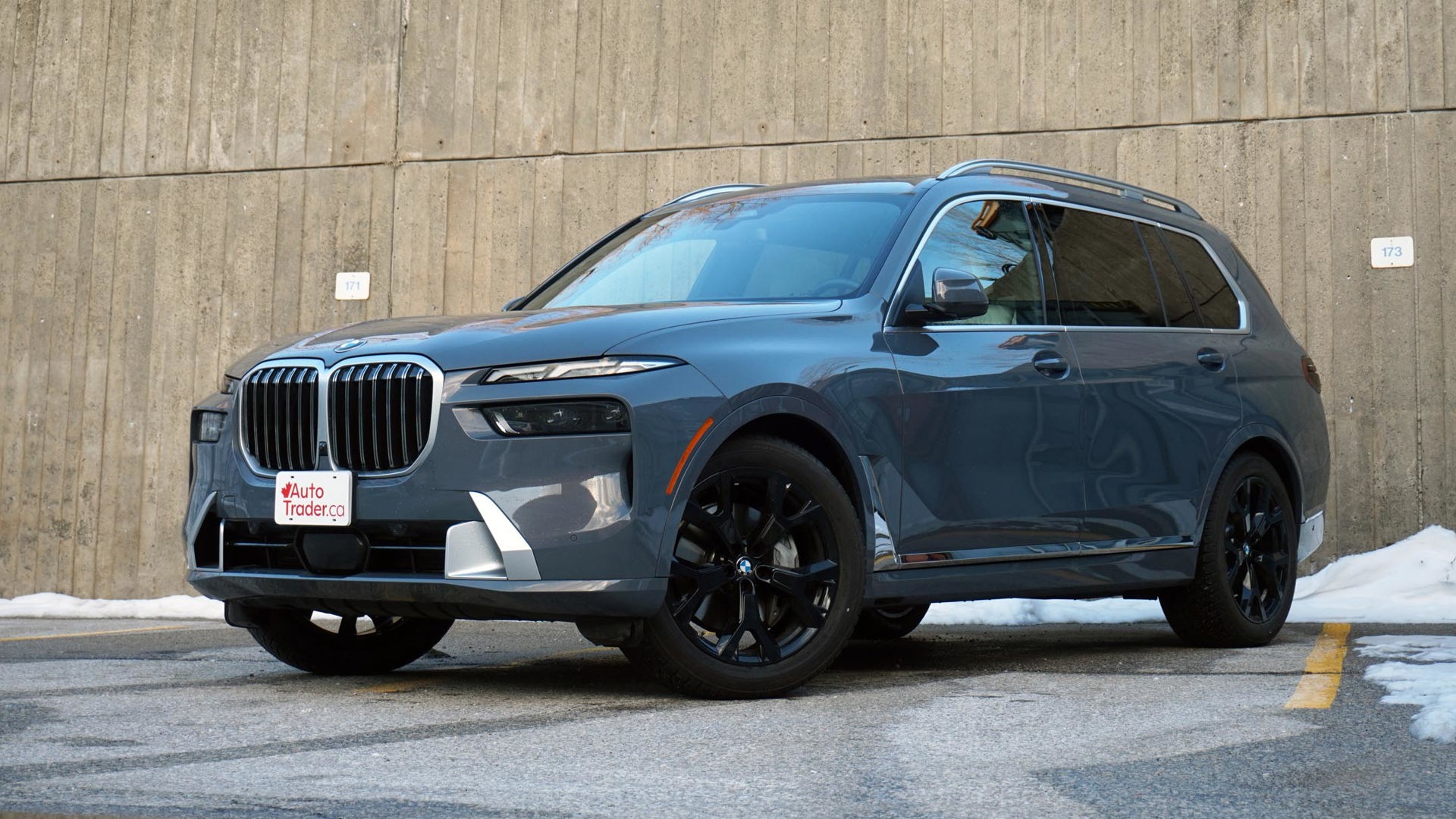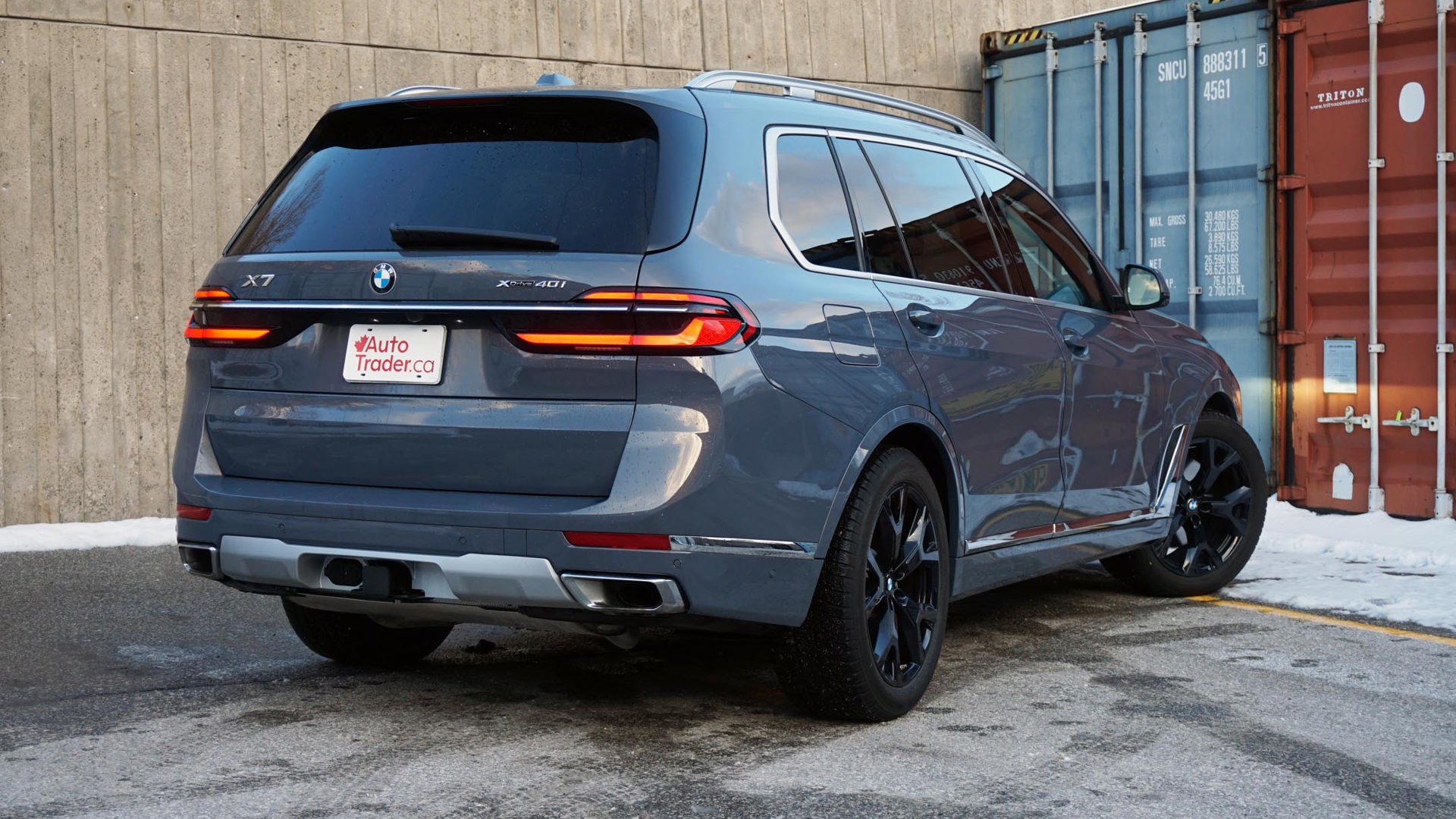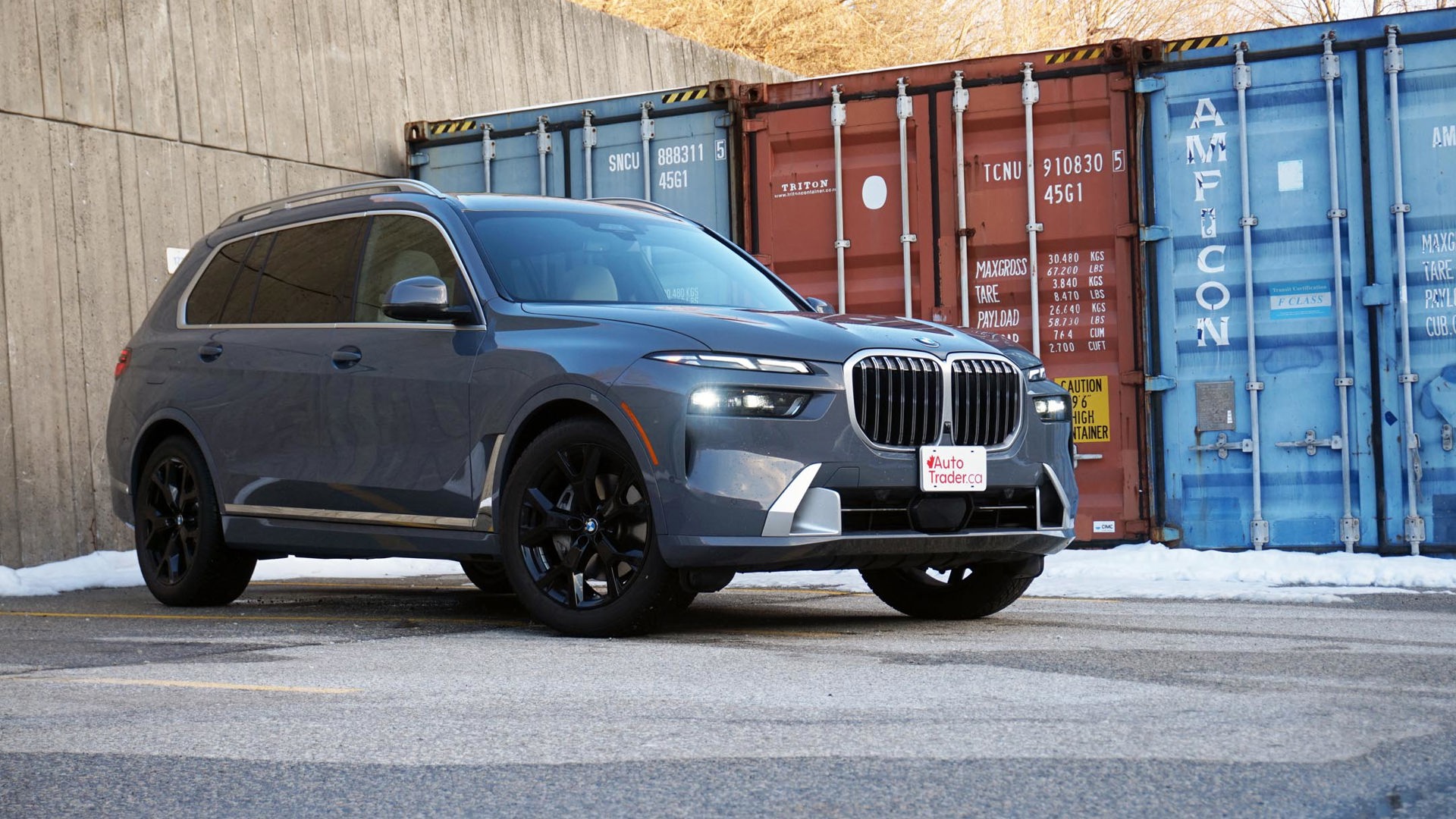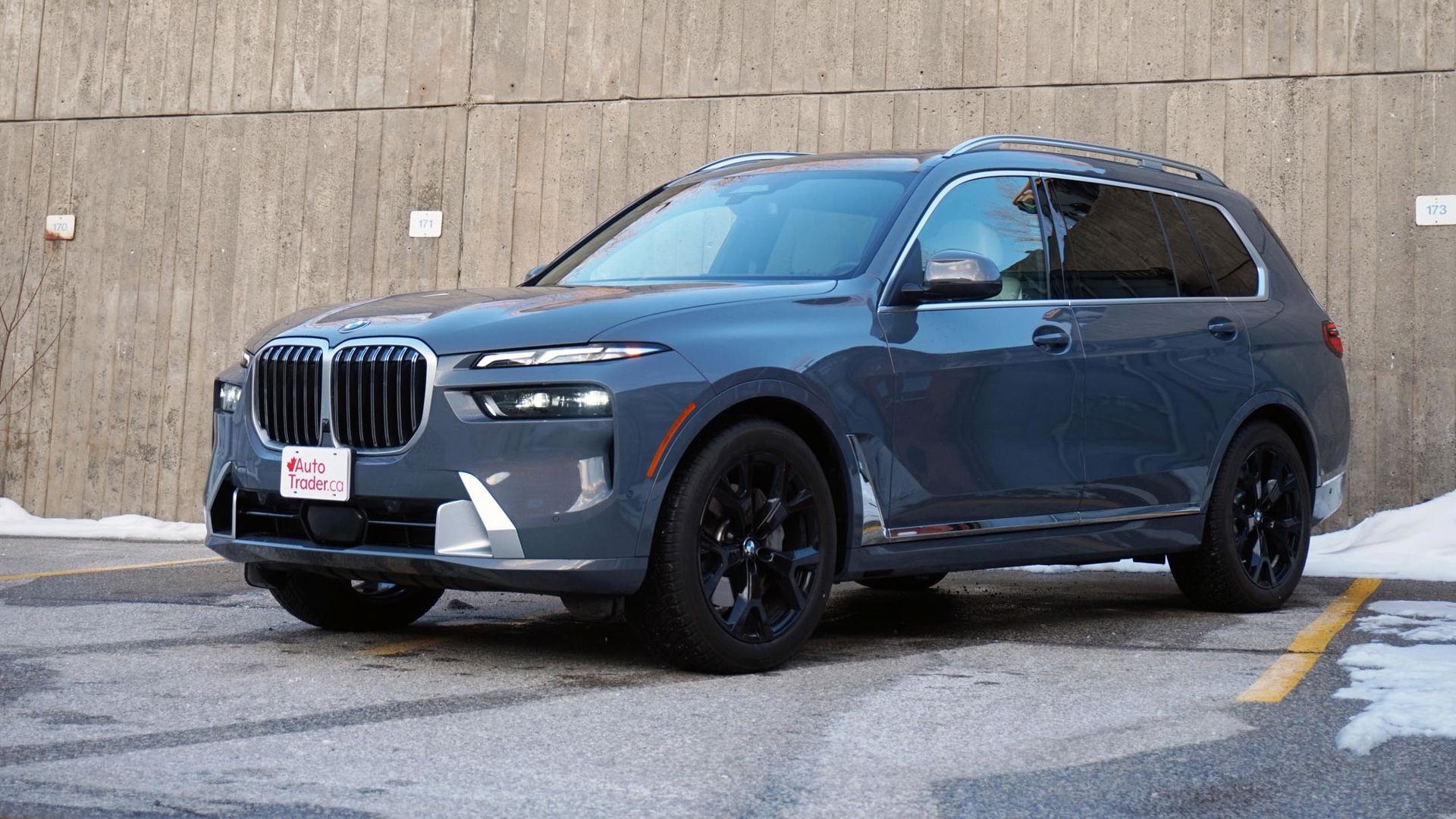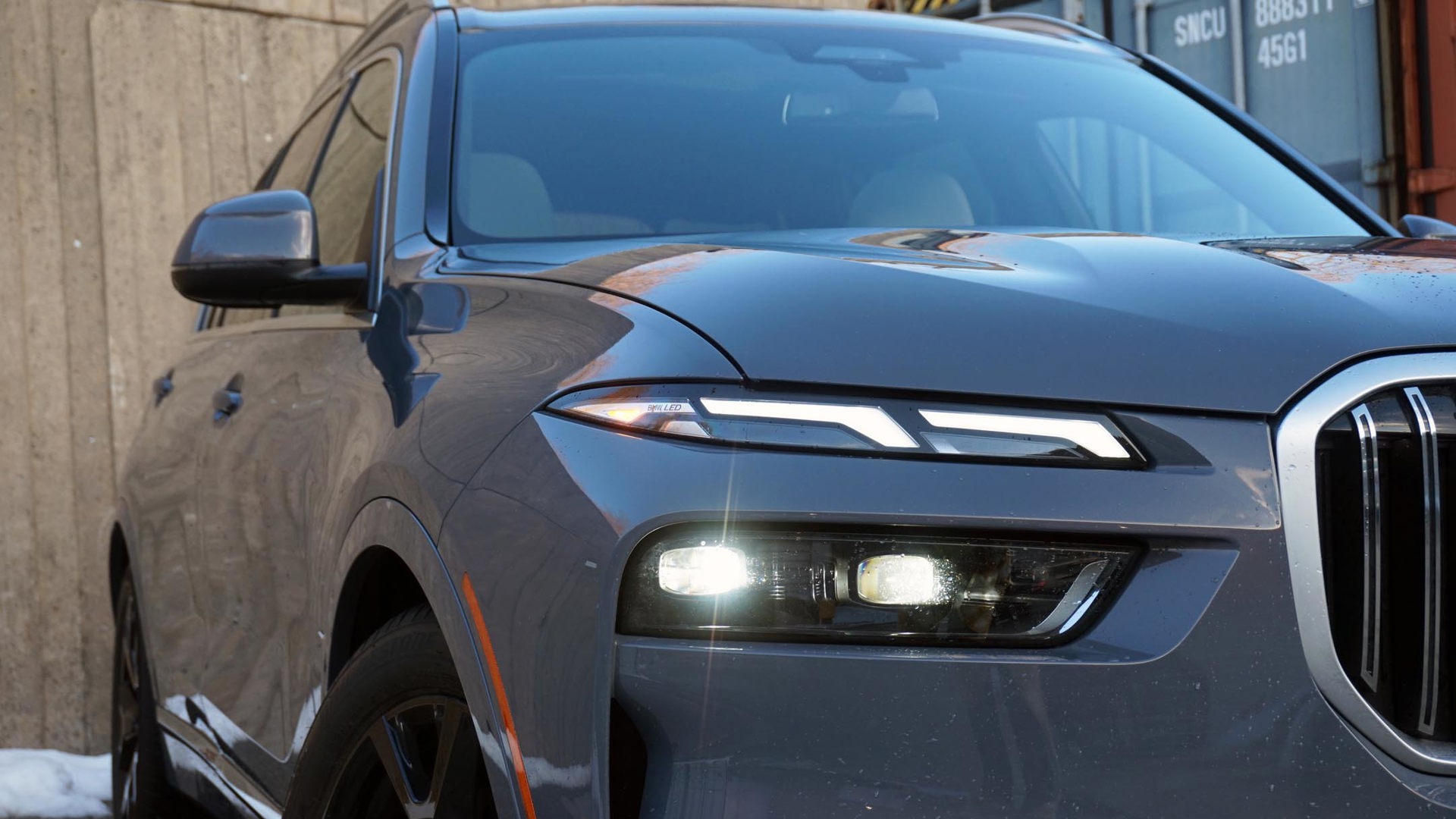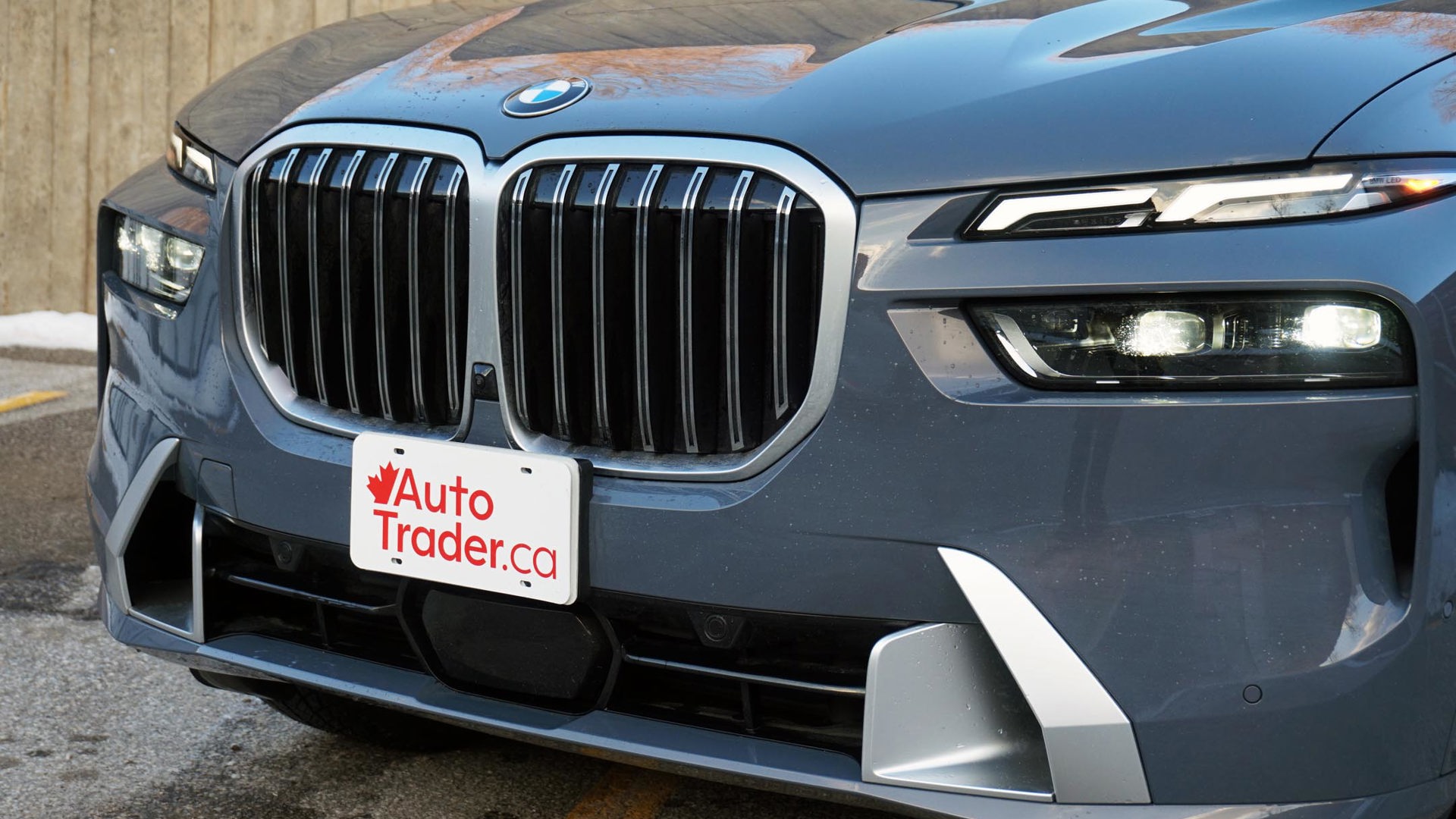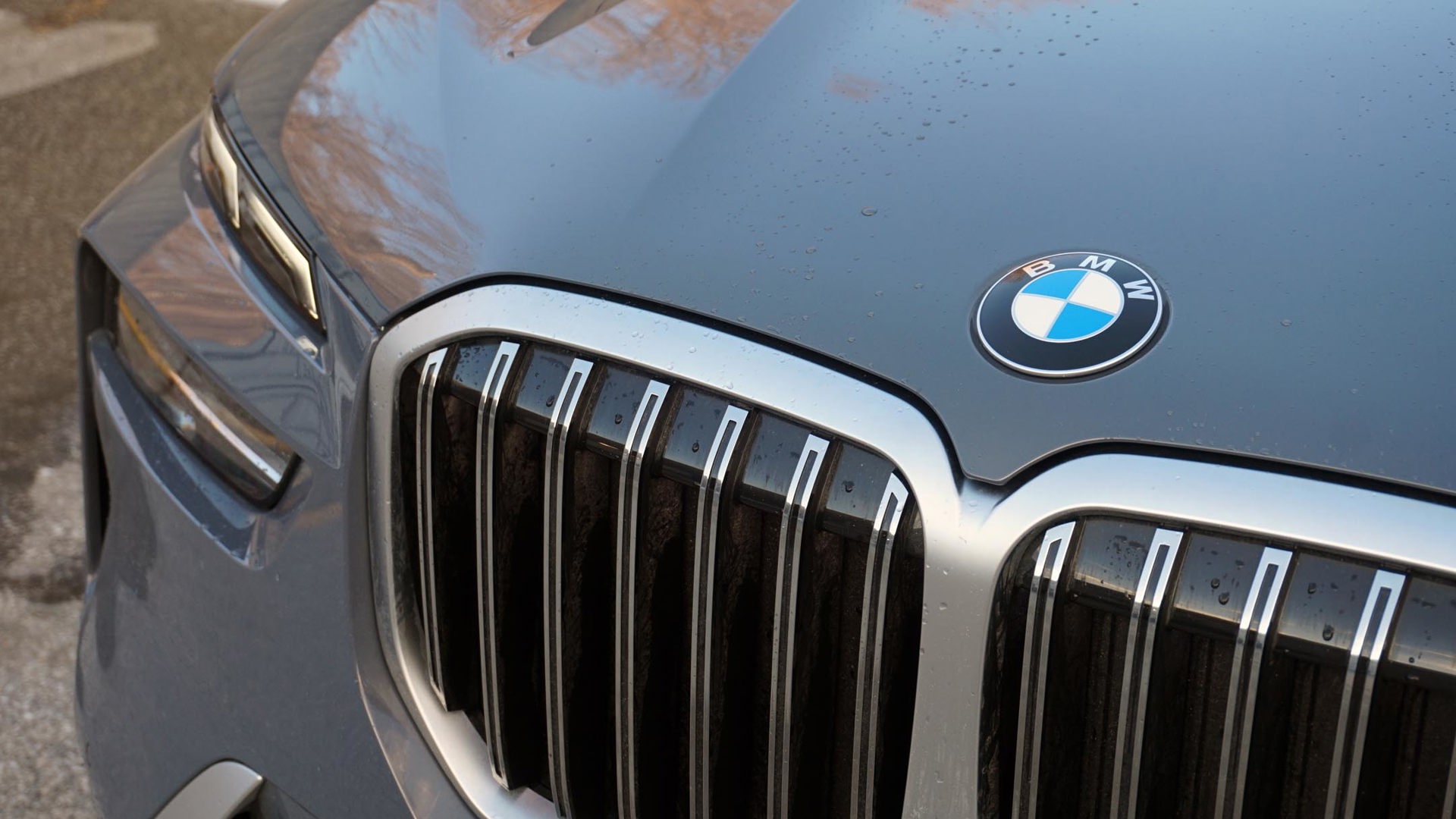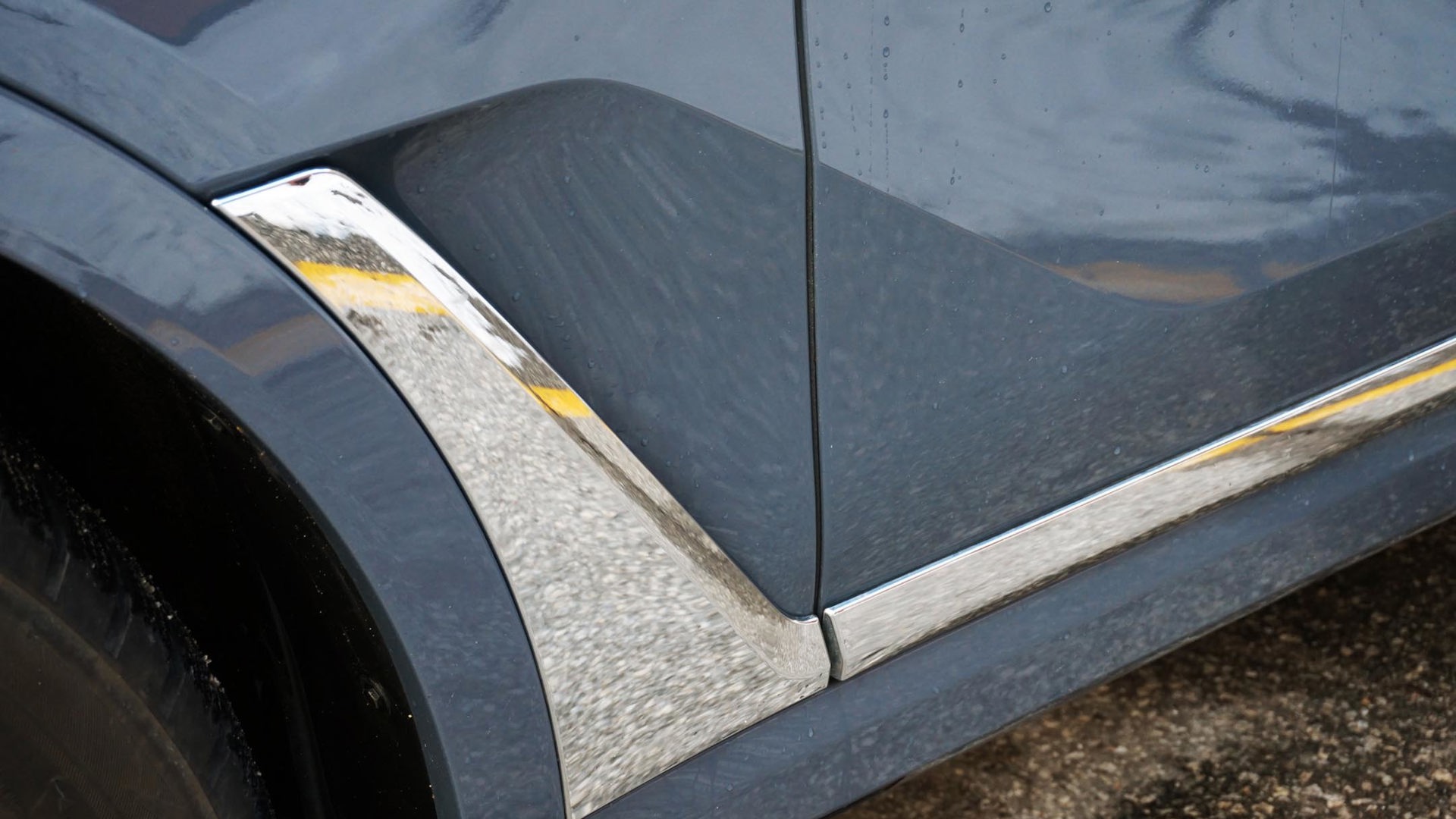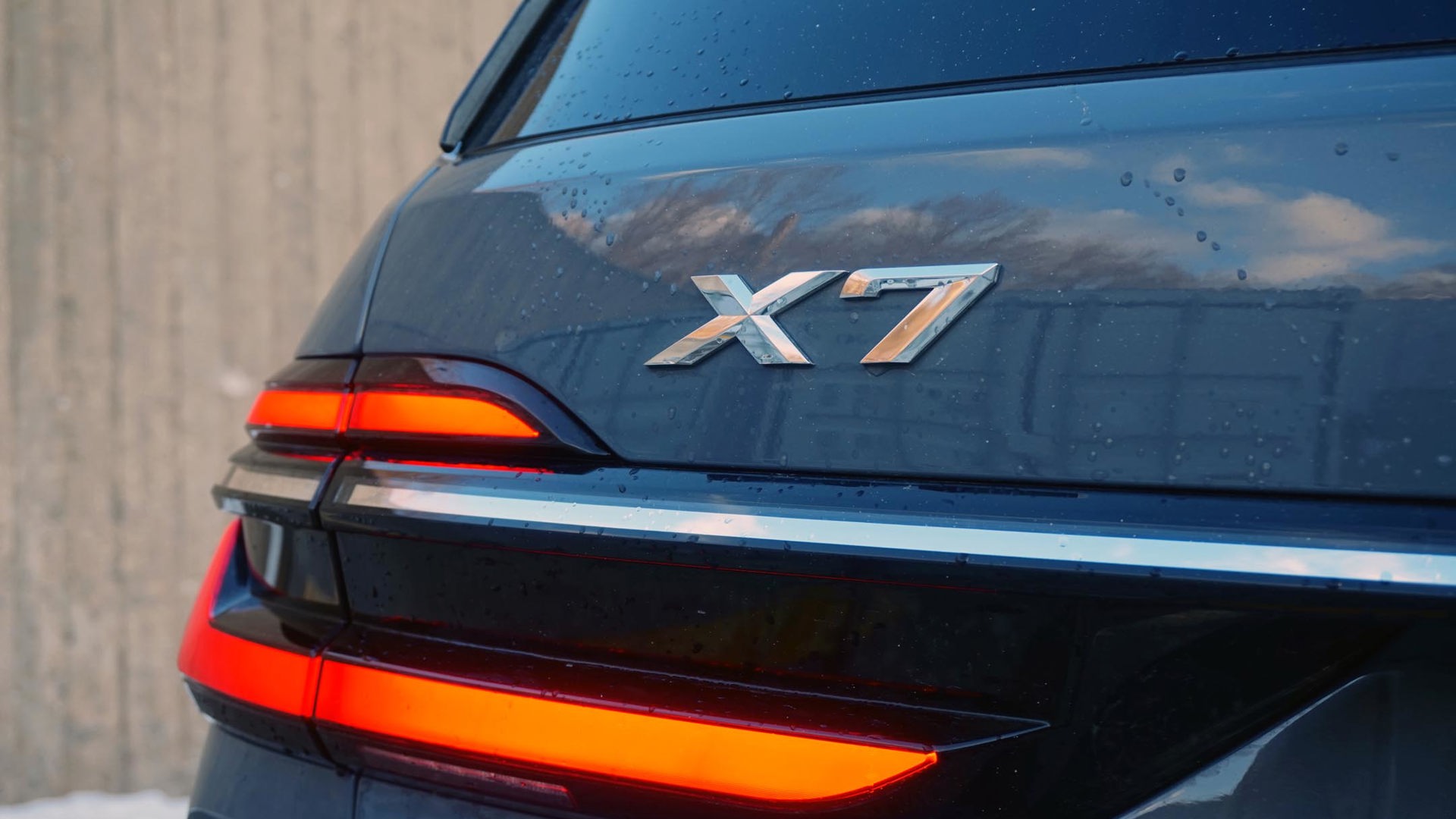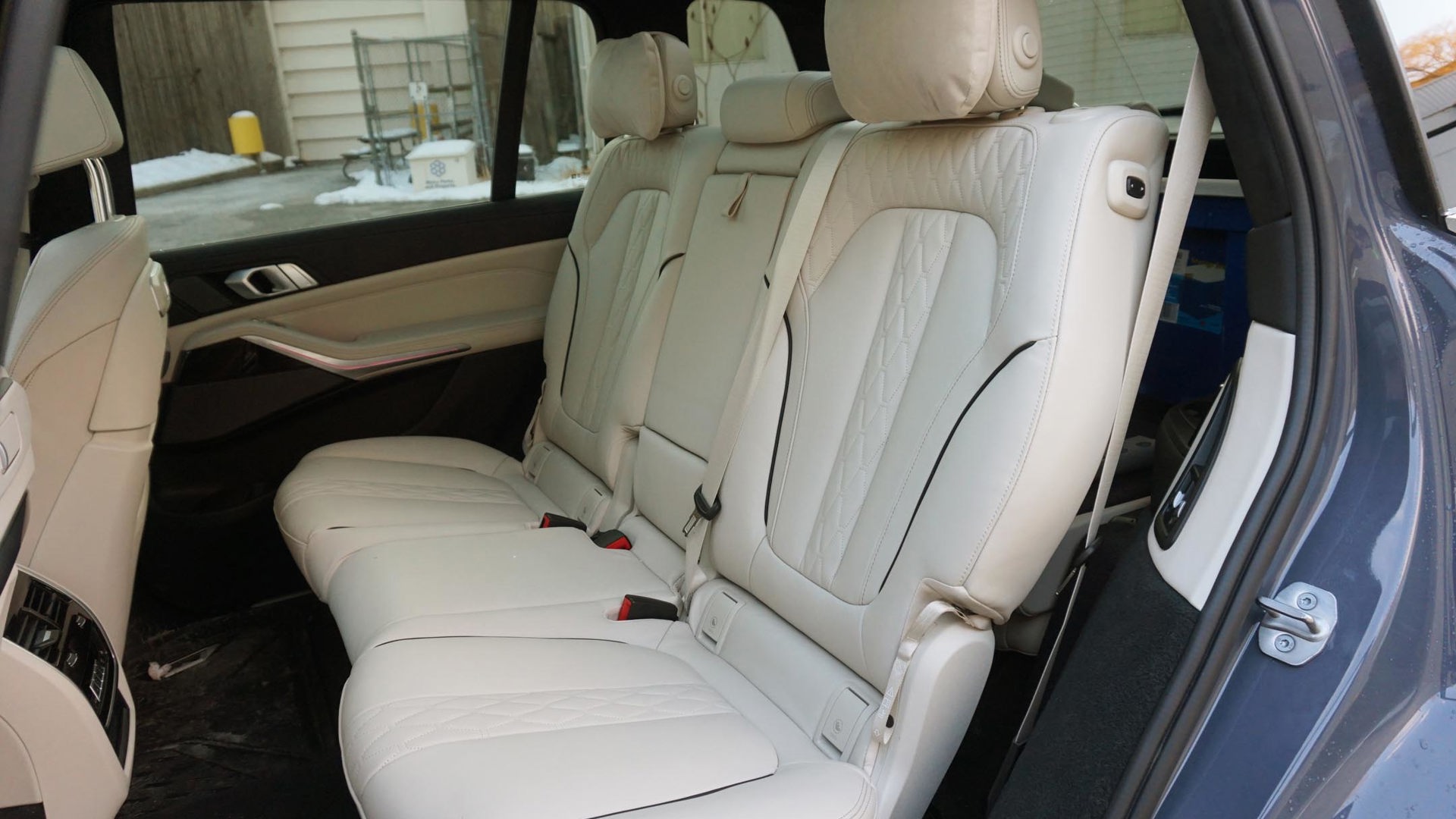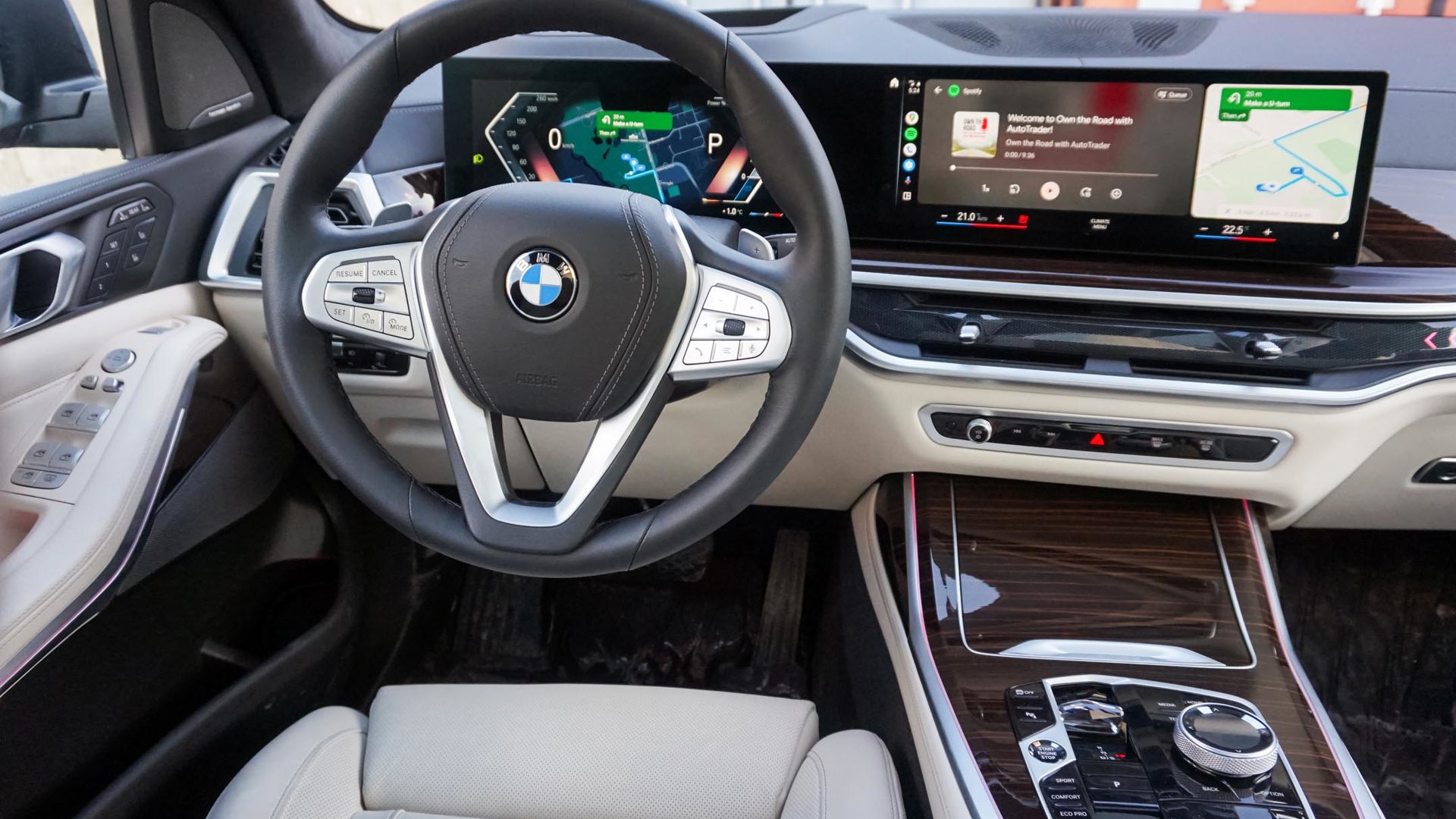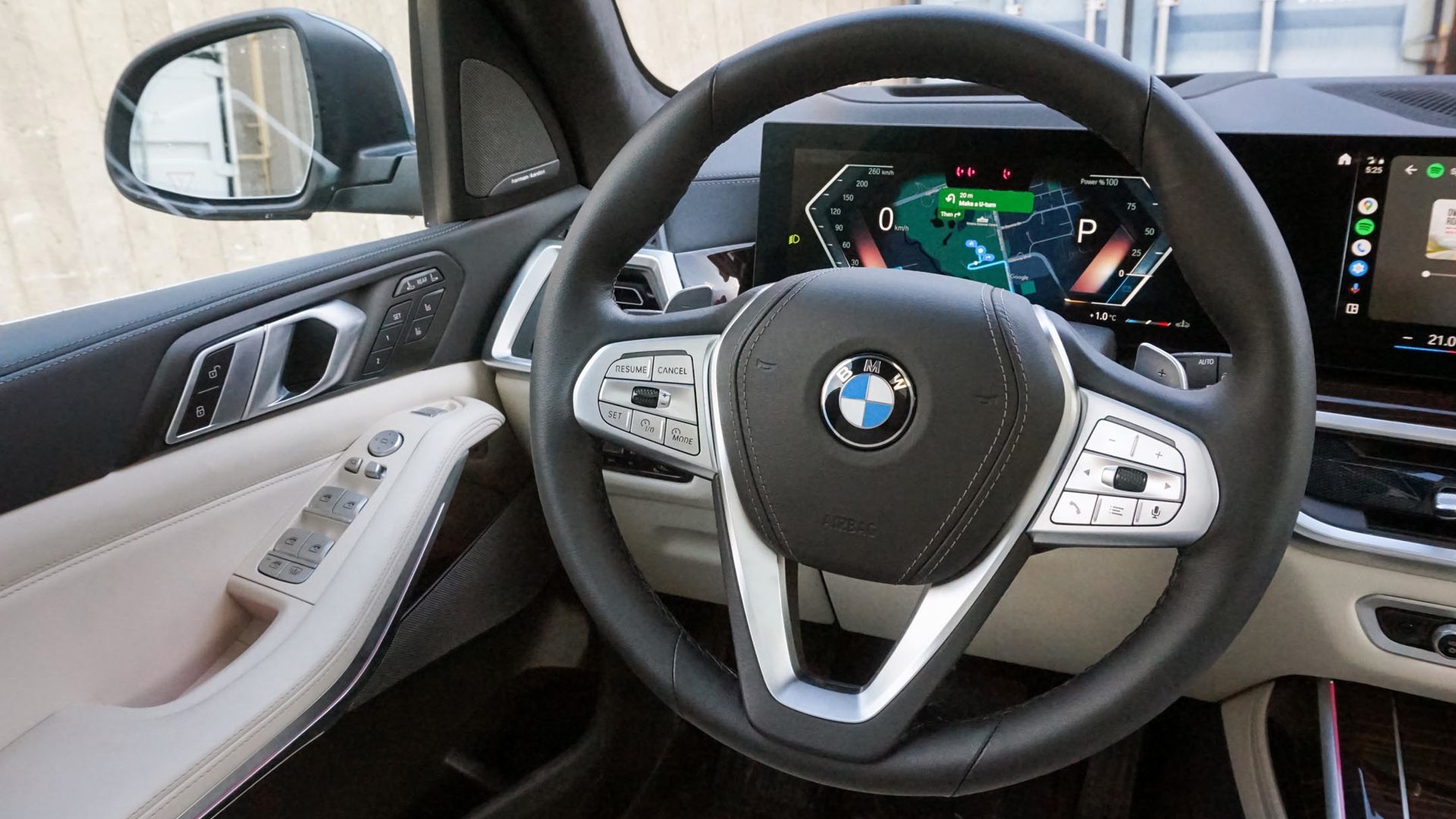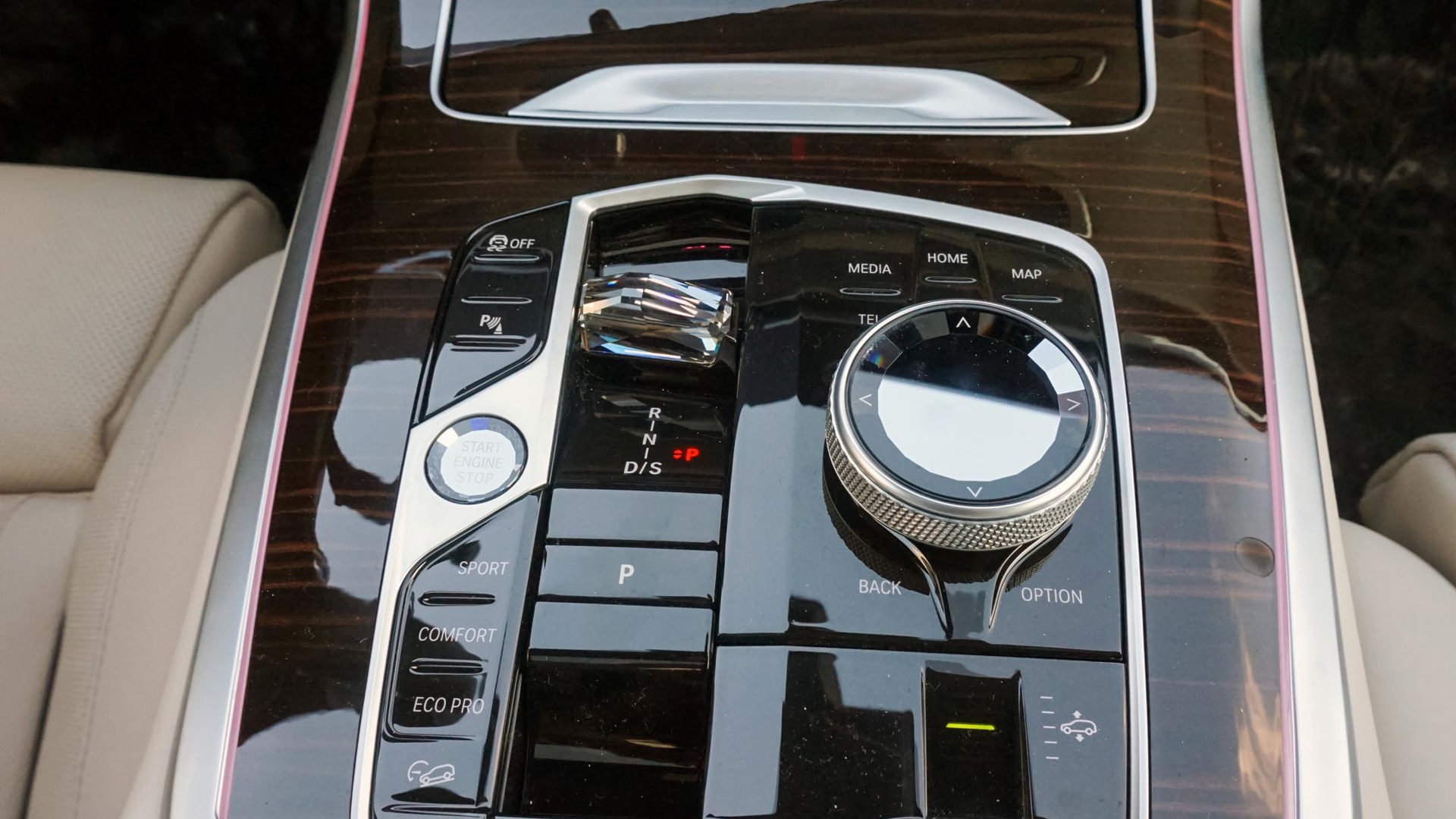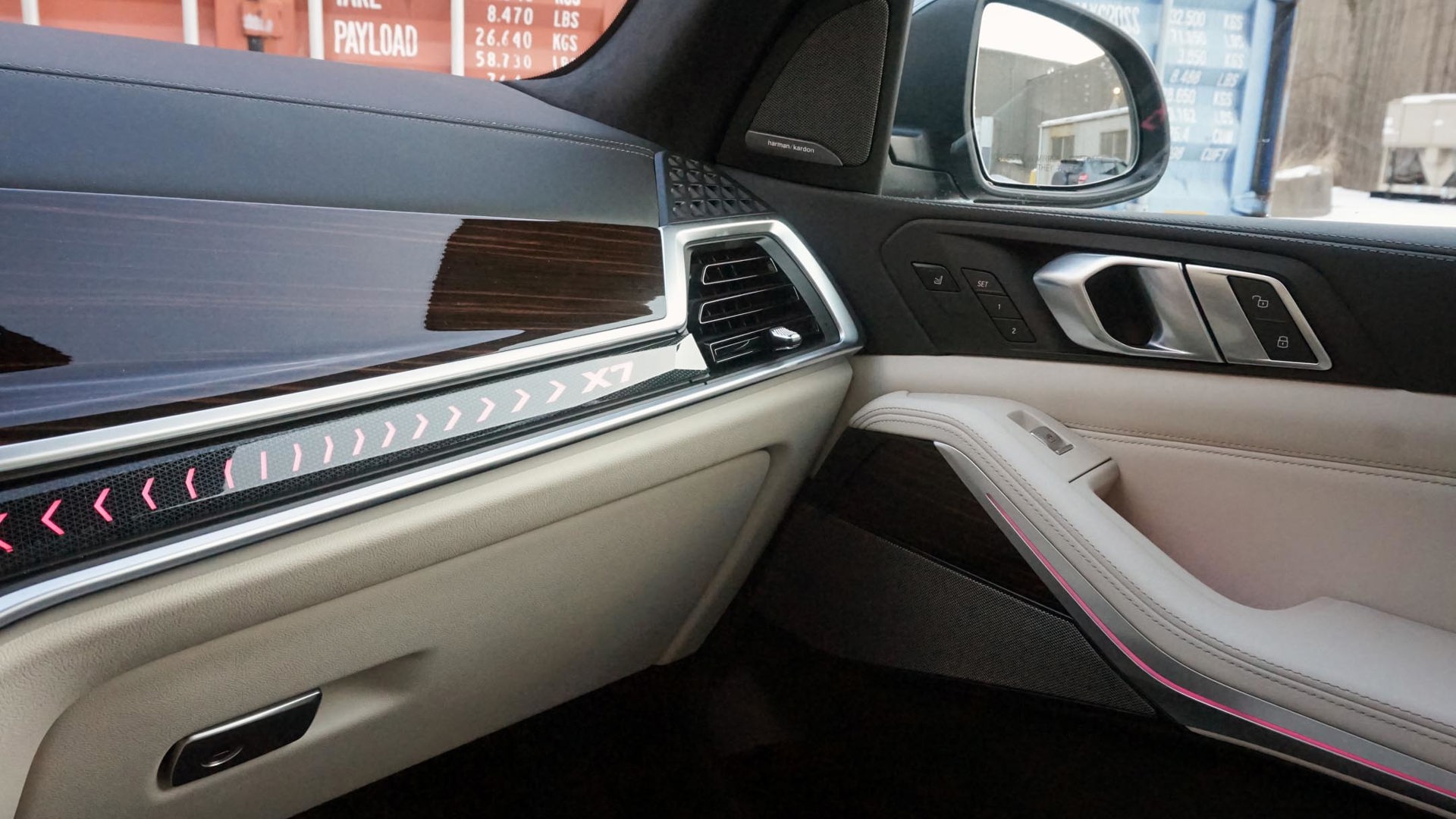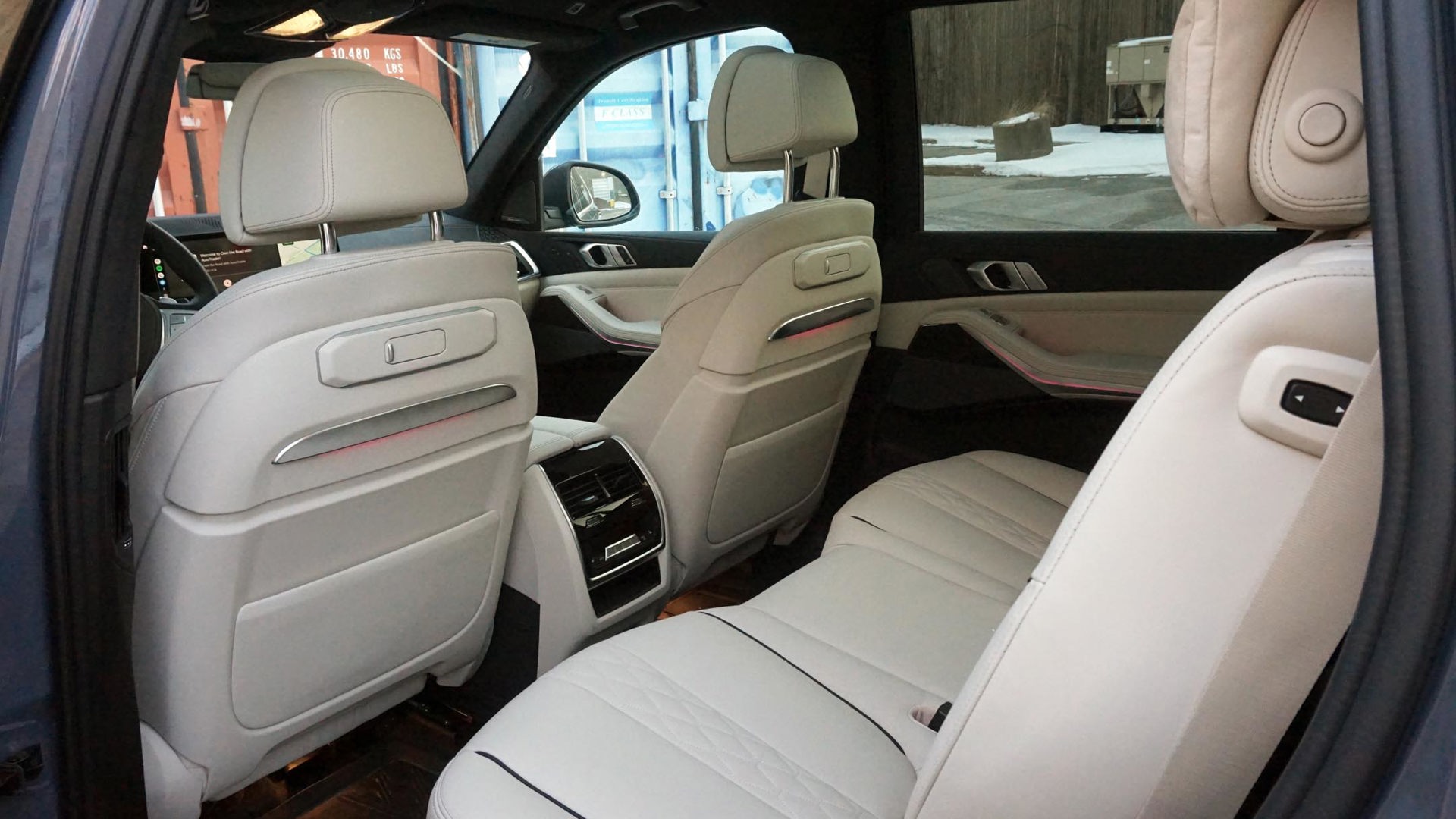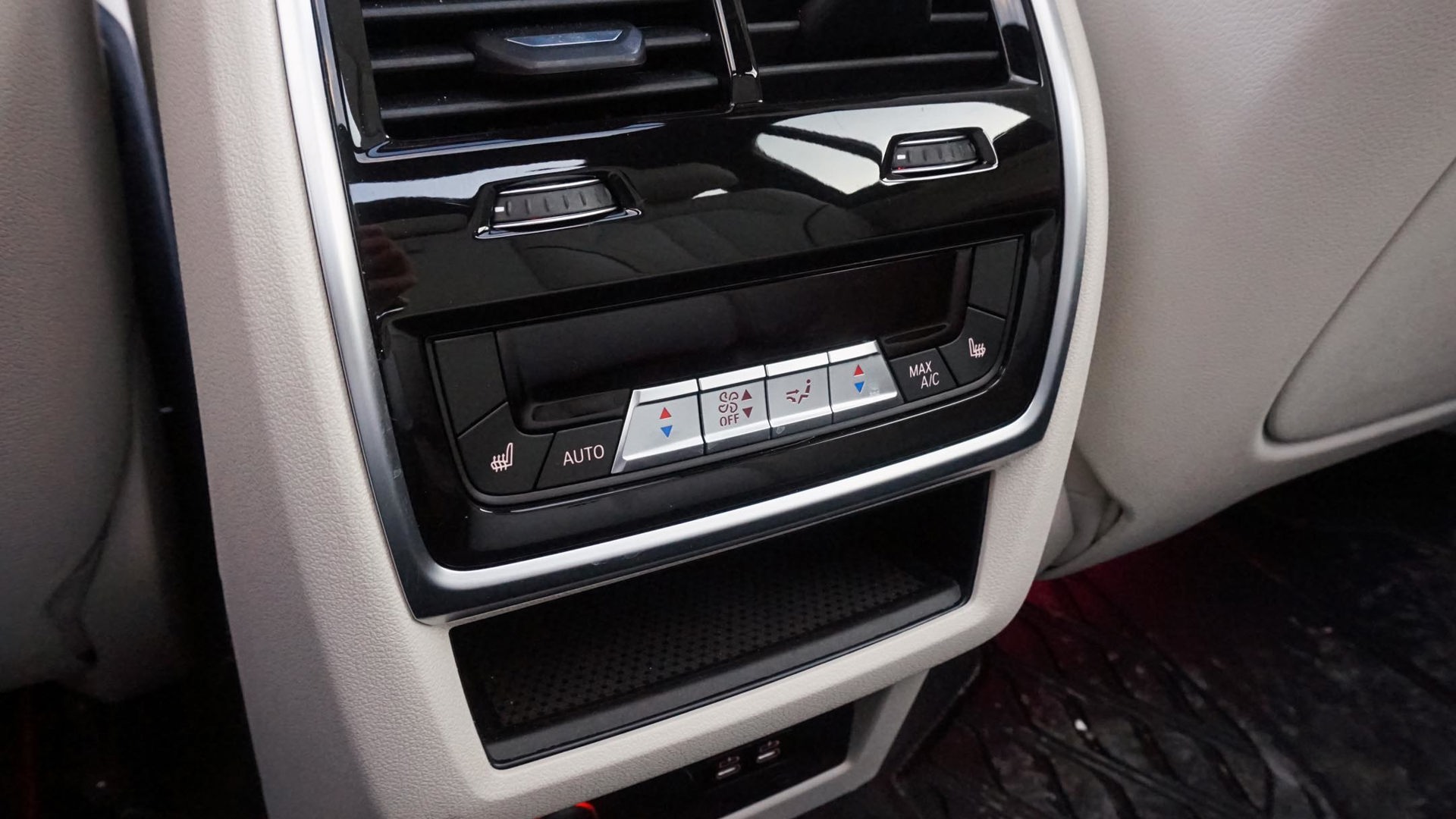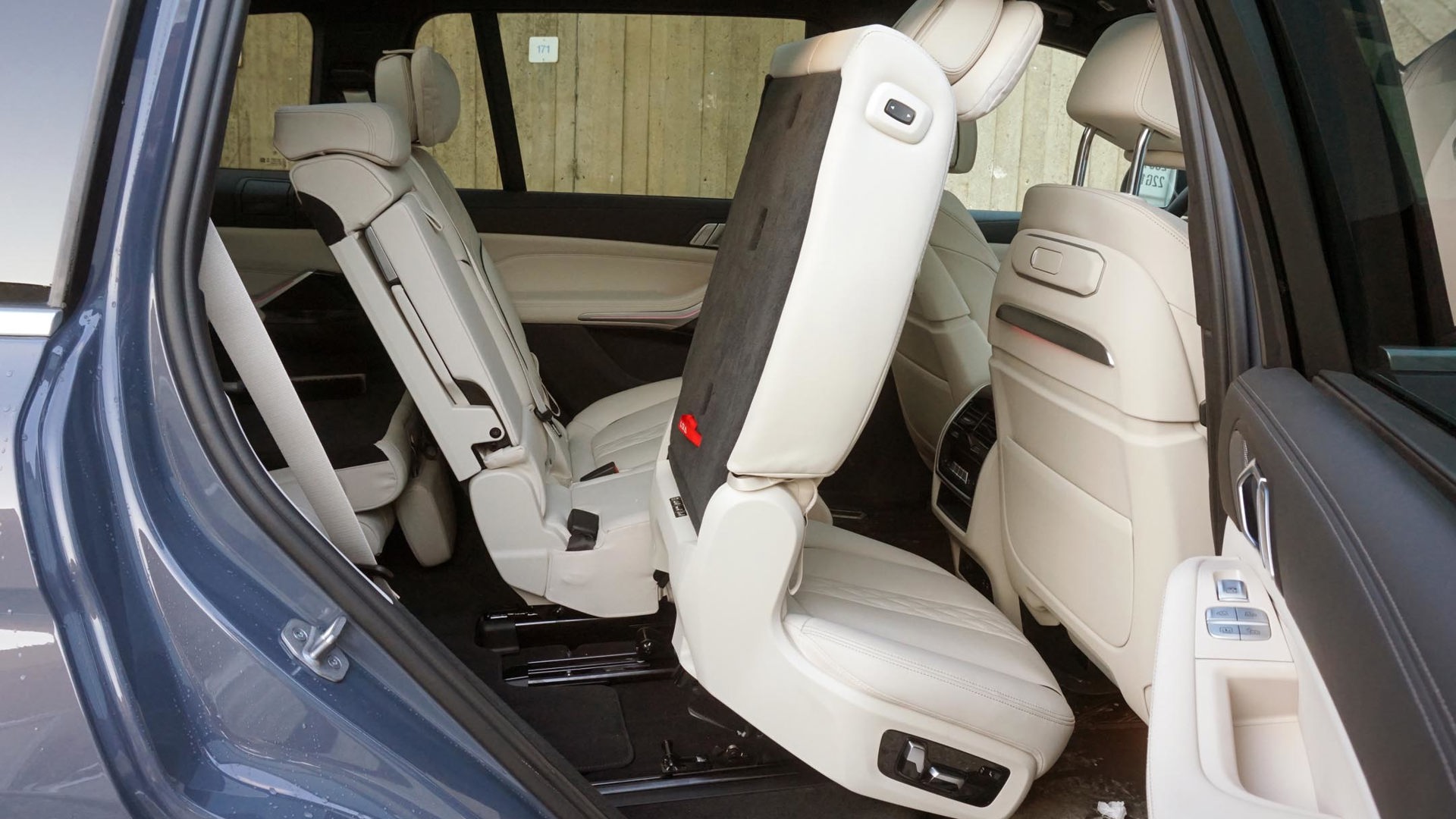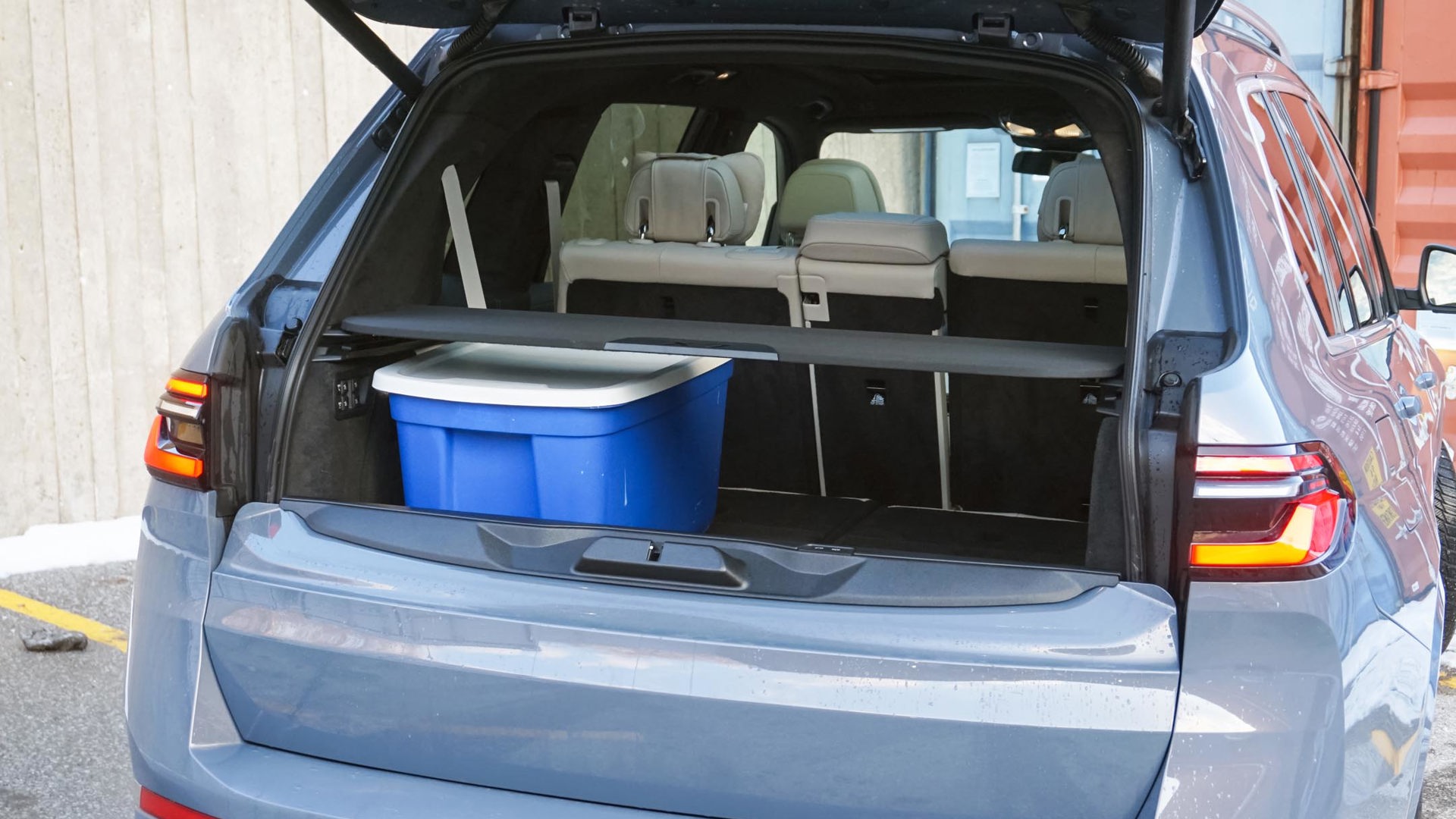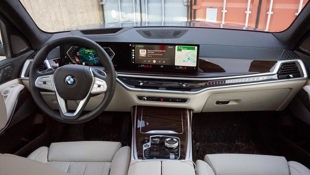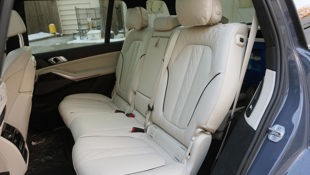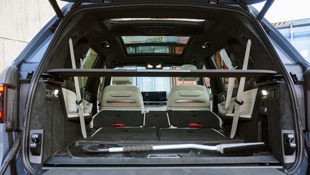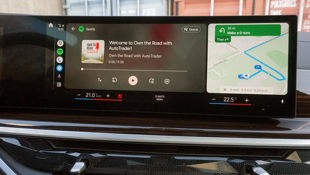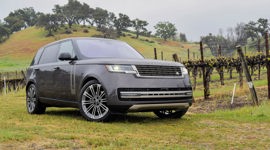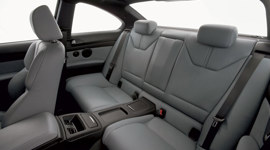 AutoTrader SCORE
AutoTrader SCORE
-
STYLING8/10
-
Safety9/10
-
PRACTICALITY9/10
-
USER-FRIENDLINESS9/10
-
FEATURES8/10
-
POWER10/10
-
COMFORT9/10
-
DRIVING FEEL9/10
-
FUEL ECONOMY8/10
-
VALUE7/10
Even though the BMW X7 debuted a few short years ago in 2019, the German automaker has already made some meaningful updates to the refreshed 2023 model.
As the brand’s largest SUV, this luxurious three-row embodies everything a vehicle of this stature should. However, sales don’t necessarily reflect how wholly impressive the X7 is. Last year, BMW sold just 977 in Canada, while Mercedes-Benz moved almost twice as many of the rival GLS-Class, with 1,697 units sold. This may not be a hugely popular segment, but that sales disparity is something of a surprise given how good the 2023 BMW X7 is.
Style: 8/10
When the BMW X7 debuted it got roasted for its enormous grille, which people said looked like buck teeth. Graciously, BMW has softened its “bigger-grille-is-better-grille” design philosophy and made the X7’s front end more palatable for 2023. The silver-coloured slats have been toned down and made slimmer, and BMW also changed its shape to make it slightly more subtle. The result is fantastic – the grille is no longer a controversial focal point, and it’s now integrated cohesively into the design. BMW also now offers an illuminated grille, which is a $500 option.
If BMW stopped there the design would have been perfect, but the brand also updated the headlights to a new split design that makes it look like this SUV is squinting. It doesn’t work on the Nissan Rogue, and it looks equally as awful on this BMW. I’m getting ready to back away slowly into a hedge like Homer Simpson, but I think the pre-refresh model looks better, even with its divisive grille.
Inside, the vibe is serious and conservatively styled but still luxurious. The wood and aluminum trim, ambient lighting, and soft leather-covered surfaces are all lovely, but the optional faceted glass controls are a highlight because they make the cabin feel special, giving it an extra sparkle. The only issue is that they’re part of a $12,500 upgrade package.
Power: 10/10
The 2023 BMW X7 xDrive40i is powered by a smooth and powerful 3.0L turbocharged inline six-cylinder engine with 375 hp and 398 lb-ft of torque, both significant increases from last year’s model. All-wheel drive is standard and power is routed through a smooth eight-speed automatic transmission. All of the elements work together effortlessly and seamlessly.
The X7’s powertrain is paired with a 48-volt mild hybrid system that’s not meant to help fuel economy but does enable some of the SUV’s other systems to run more efficiently. The mild hybrid system enables a super smooth and barely perceptible ignition stop-start system, allows the climate control to continue running even if the engine is shut off at a stoplight, and also introduces a new “sprint” function. When the driver holds the left paddle shifter down for one second, the transmission goes into the lowest usable gear and the mild-hybrid system augments the gas engine’s power with an electric boost for when a quick burst of acceleration is required.
The X7’s powertrain is already so adept that this boost function ends up being somewhat of a gimmick, but it’s one element that helps a driver feel more engaged. Officially, the X7 accelerates from zero to 100 km/h in 5.8 seconds, which is wild when you consider how large it is.
Driving Feel: 9/10
Being the large and luxurious SUV it is, the X7 doesn’t handle like a BMW sports car, and it would be unrealistic to expect otherwise. It is, however, one of the smoothest vehicles I’ve ever experienced outside of a Rolls-Royce or Maybach. This year, an adaptive and self-levelling air suspension is included as standard, which makes the big SUV feel like it’s floating over even the most busted roads.
Combined with the optional Dynamic Handling package ($4,750), the air suspension works with the navigation system, driving style, and cameras to make sure it’s always in the optimal setting: stiffer when hustling through winding roads, and softer when out for a leisurely cruise. It also has active roll stabilization so the SUV is able to keep itself remarkably flat in corners and during acceleration and braking.
Four-wheel steering is also part of the Dynamic Handling pack, which makes it an essential upgrade simply because it makes the X7 feel more nimble and easier to manoeuvre around tight parking garages and parking lots. This SUV makes U-turns and slides into parking spots like it’s nobody’s business.
Comfort: 9.5/10
The result is remarkable comfort for all seven passengers (or six if you opt for second-row captain’s chairs). No matter how you’re driving or where you’re going, all occupants are treated to a luxurious experience.
Five-zone climate control is standard, along with heated seats in all three rows, heated and cooled cup holders in the front, USB ports for all passengers, pillows for the second-row headrests, and sunshades for the rear windows. This is also the first time I’ve seen front seats and a steering wheel with a high and very high heat settings. Bonus points awarded for the heated armrests – a warm hug that’s appreciated on chilly drives.
Room in the third row is also surprisingly decent for someone my size (5-foot-6) but might be a bit tight for anyone taller. The second row can also slide forward to make more room for passengers in the rearmost seats.
The only improvement I’d ask for is to have the doors extend beyond the rocker panels. The winter weather was a mess while I was testing the X7, so the rocker panels got covered in slush and salt. Every time I got out of the car, that grime would leave my pant legs annoyingly dirty.
Practicality: 9.5/10
BMW nailed the practicality aspect of this large SUV, which was a surprise to me. Opening the split tailgate reveals 363 L of space in the trunk, which expands to 1,376 L with the third row folded and 2,560 L with all the back seats stowed. I wish the tailgate could close in one step instead of needing to push two buttons, and that there was more small item storage in the second row, but those are minor gripes.
I love how BMW elegantly engineered the seat and cargo configurations. There are buttons in the trunk for maximum passenger space or maximum cargo space. One push (you don’t need to hold the button down) is all it takes for the fully automated system to fold the headrests down in the second- and third rows, move the first- and second rows forward to make room so the folding seats don’t catch it, and then fold the seatbacks flat. This is one of the smartest and most practical systems I’ve seen in a three-row SUV because it doesn’t require you to wait while holding a button or run around the whole car to fix the seats.
With all three rows in use, it takes just one touch to tumble the second-row seat forward so someone can get into the back, and it’s easy enough that a kid should be able to do it on their own. The second row also folds in a very European 40/20/40 split, so the middle section can fold independently, allowing longer items to fit while still having room for four adults. The X7 is also rated to tow 2,450 kg (5,400 lb) and comes with a hitch and a towing assistant that’s similar to Ford’s, allowing the vehicle to be controlled using the rotary dial on the console that sends the trailer in the correct corresponding direction when reversing.
Features: 8/10
One standout feature is actually two: the new digital instrument cluster and infotainment screen, both of which are housed under a single piece of curved glass, so it all looks clean and crisp. Wireless Android Auto and Apple CarPlay are included as standard and are integrated beautifully. If you’re using Google Maps, for example, you can view the navigation instructions in the head-up display and the customizable digital gauge cluster. Not only does the smartphone interface use up all the available real estate, but you can see up to three apps on the screen at once, whereas most systems can only handle one or two apps.
I also love that the BMW unlocks as you approach, locks as you walk away, and also greets you with a light show. This BMW is stuffed with helpful features to enhance comfort, driving dynamics, connectivity, convenience, security, and luxury, but like many luxury automakers, you have to pay extra for many of them.
Safety: 9/10
BMW includes almost all of its safety features as standard, however, including automatic high-beam assist, lane departure warning, forward collision warning with pedestrian and cyclist detection and automatic emergency braking, speed limit information, lane-keep assist, safe exit warnings, and more. The add-ons are part of a sensibly priced $2,000 upgrade package that includes adaptive cruise control with stop and go, blind-spot monitoring with rear cross-traffic alert, traffic jam assistant, steering and lane control, collision evasion assist, and an advanced self-parking system.
User-Friendliness: 9/10
The X7’s ease of use also surprised me. I’ve always found BMW controls to be over-engineered and finicky, but the X7 was intuitive and easy to use right from the get-go with almost no learning curve.
The X7 offers three ways to interact with the infotainment system: a touchscreen, a rotary dial near the gear selector, and voice commands. I still think voice commands are awkward to use and gimmicky, but I do love having both the dial and the touchscreen to control the system. The touchscreen is easier to use when you’re parked, while the dial is easier while you’re driving. I wish there were hard buttons or better shortcuts for the climate control, but it helps that the SUV remembers your settings. If you turn on the heated seats and steering wheel, for example, it will remember the next time you get into the car. The infotainment menus have also been simplified so there’s less digging for what you’re looking for and the layout is logical.
Fuel Economy: 8/10
The BMW X7 xDrive40i is officially rated to burn 11.3 L/100 km of the finest 91-octane fuel in the city, 9.5 on the highway, and 10.5 combined. After more than 550 km of mixed testing on winter tires and in frigid temperatures, the X7 averaged 11.7 L/100 km, which is better than I expected for an SUV of this size with a six-cylinder under the hood.
Value: 7/10
For a six-figure luxury SUV, I was hoping that the X7 would include more features as standard (even ventilated seats are part of an expensive options package). The 2023 BMW X7 starts at $108,500 plus the non-negotiable $2,480 destination fee. With a bunch of options added in, the total of this tester comes to $132,730 before sales and luxury taxes.
The Verdict
I’m still not sure why I don’t see more BMW X7s on the roads. BMW has pretty much nailed it with this three-row SUV, offering practicality and comfort in a high-end package. Yes, it’s still kind of ugly, but the rest of it is so good that it easily outweighs that, so if you’re in the market for a big, luxurious three-row SUV with all the fixings, you should definitely put the 2023 BMW X7 on your list.
| Engine Displacement | 3.0L |
|---|---|
| Engine Cylinders | Turbo I6 |
| Peak Horsepower | 375 hp @ 5,200–6,250 rpm |
| Peak Torque | 398 lb-ft @ 1,850–5,000 rpm |
| Fuel Economy | 11.3 / 9.5 / 10.5 L/100 km city/hwy/cmb |
| Cargo Space | 363 / 1,376 / 2,560 L seats up/down |
| Model Tested | 2023 BMW X7 xDrive40i |
| Base Price | $108,500 |
| A/C Tax | $100 |
| Destination Fee | $2,480 |
| Price as Tested | $132,830 |
|
Optional Equipment
$21,750 – Premium Excellence package, $12,500; Dynamic Handling package, $4,750; Advanced Driver Assistance package, $2,000; 23-inch light alloy wheels, $2,000; Illuminated Kidney Grille, $500
|
|




